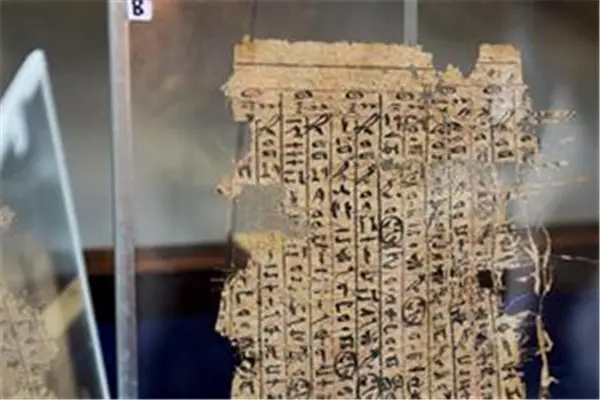The Cairo's Egyptian Museum showcased for the first time a collection of papyri that date back to King Khufu, who ruled during the Fourth Dynasty in the first half of the Old Kingdom period (26th century BC) in ancient Egypt.
The papyri were discovered in 2013 at the Red Sea Wadi El-Jarf port, 120 km south of the town of Suez, by a Franco-Egyptian mission led by French Egyptologist Pierre Tallet and Egyptian Egyptologist Sayed Mahfouz.
The papyri, the oldest ever written ones found in Egypt, were placed at the heart of the Museum under spotlights in a glass display case.
"The papyri talk about the daily life of the workers who used to work in the Wadi El-Jarf port," Egyptian Antiquities Minister Khaled El-Enany told reporters during a ceremony at the Museum, adding "they are almost the same workers who constructed the Great Giza Pyramid of King Khufu."
This indicates the highly efficient administrative system during Khufu's reign, he said.
The minister stressed that the papyri predate the El-Gebelein papyri, which date back to the end of the 4th dynasty, and the Abusir papyri, which date to the end of the 5th dynasty.
The most important one among the papyri is that of a middle-ranking official called Merer, who was in charge of a team of sailors.
A part of King Khufu's papyri is displayed for the first time at the Egyptian Museum in Cairo, Egypt on July 14, 2016. The Cairo's Egyptian Museum showcased for the first time a collection of papyri that date back to King Khufu, who ruled during the Fourth Dynasty in the first half of the Old Kingdom period (26th century BC) in ancient Egypt. Photo By: Zhao Dingzhe, Xin Hua
Named the "Log of Merer," the papyrus is composed of two fragments measuring originally 1.5 to 2 meters long.
The papyrus gives an everyday account of the work of this crew in transporting limestone blocks from the quarries of Turah on the east bank of the Nile in Cairo to the pyramid of Khufu at the Giza Plateau through the Nile and its canals.
It also indicates that there was a logistics center; called Ro- She Khufu, where most of the executive procedures were ended.
The center was under the authority of vizier Ankh-Haef, half-brother of Khufu, who was probably in charge of building the pyramid at the end of King Khufu's rule.
Along with the discovery of the papyri, the Franco-Egyptian team also discovered an ancient harbor complex, the oldest harbor ever found in the world, another proof that Khufu was a great ruler with a well-organized bureaucratic system.
The Wadi al-Jarf harbor complex contained docks, stone anchors, storage jars, fragments of rope and pieces of pottery as well as caves used as accommodations for the port workers.
Museum curator Sabah Abdel-Razek said that most of these papyri are accounting documents, and that they indicate that Khufu held power for 26 years, which contradicts earlier estimates on how long he was pharaoh.
"These discoveries should not be hidden in boxes...We need to attract the attention of the whole world to Egypt; that is why I decided to showcase the papyri because such relics will revive tourism in Egypt," he said.
Tourism in Egypt was dealt a heavy blow following the Russian airplane crash in North Sinai in October, after which several countries, including Britain and Russia, suspended their flights to Egypt.
The North African country is striving to revive the ailing tourism industry. However, anti-government terror attacks by Islamist militants have led many countries to warn their residents of traveling to Egypt.
Since the 2011 uprising that toppled former long-time leader Hosni Mubarak, Egypt has descended into political, economic and social chaos, causing a recession to its tourism industry, one of the main sources of the country's national income and foreign currency reserves.
The peak of tourism in Egypt was in 2010 when 14.7 million tourists visited the county, providing revenues of nearly 12.5 billion U.S. dollars.
(APD)
 简体中文
简体中文

